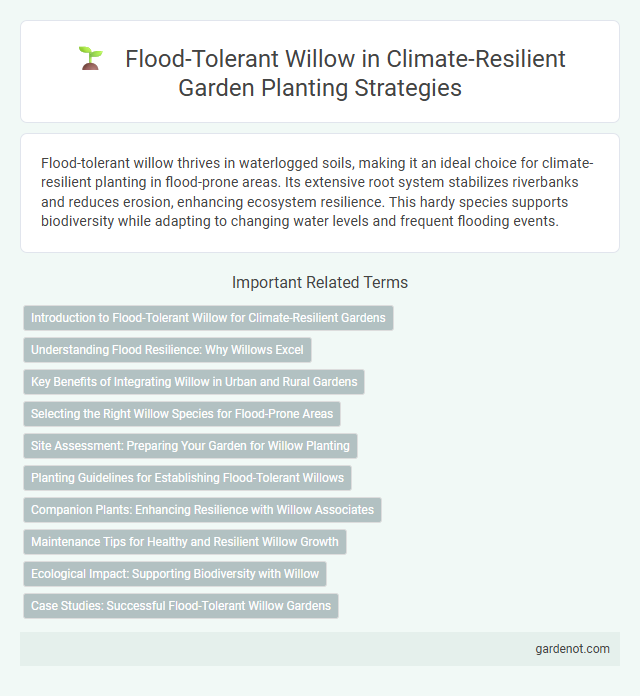Flood-tolerant willow thrives in waterlogged soils, making it an ideal choice for climate-resilient planting in flood-prone areas. Its extensive root system stabilizes riverbanks and reduces erosion, enhancing ecosystem resilience. This hardy species supports biodiversity while adapting to changing water levels and frequent flooding events.
Introduction to Flood-Tolerant Willow for Climate-Resilient Gardens
Flood-tolerant willow species are ideal for climate-resilient gardens due to their exceptional ability to withstand prolonged water saturation and recover quickly from flood events. Their deep, fibrous root systems stabilize soil and reduce erosion, making them valuable for riparian buffer zones and wetlands restoration. Incorporating flood-tolerant willow enhances water management and biodiversity, supporting ecosystem resilience under shifting climatic conditions.
Understanding Flood Resilience: Why Willows Excel
Flood-tolerant willows exhibit exceptional resilience due to their extensive root systems and adaptive physiology that enable survival in saturated soils. Their capability to withstand prolonged inundation reduces erosion and stabilizes riverbanks, making them vital in flood-prone ecosystems. Understanding these traits enhances climate-resilient planting strategies for sustainable landscape management.
Key Benefits of Integrating Willow in Urban and Rural Gardens
Flood-tolerant willow enhances soil stabilization and reduces erosion in both urban and rural gardens, improving water management during heavy rainfall. Its fast growth and high tolerance to waterlogged conditions support biodiversity by providing habitat for various bird and insect species. Integrating willow contributes to carbon sequestration and helps create resilient landscapes against climate-induced flooding.
Selecting the Right Willow Species for Flood-Prone Areas
Selecting the right flood-tolerant willow species, such as Salix alba and Salix nigra, is crucial for climate-resilient planting in flood-prone areas. These willow varieties exhibit high adaptability to saturated soils and frequent inundation, supporting soil stabilization and reducing erosion. Proper site assessment and species matching enhance survival rates and promote ecosystem resilience against climate-induced flooding events.
Site Assessment: Preparing Your Garden for Willow Planting
Flood-tolerant willow thrives in wet, waterlogged soils, making site assessment crucial for successful planting. Evaluate soil drainage, moisture retention, and proximity to flood-prone areas to ensure optimal growing conditions. Properly preparing your garden with these considerations enhances the willow's ability to withstand seasonal flooding and supports healthy growth.
Planting Guidelines for Establishing Flood-Tolerant Willows
Flood-tolerant willows thrive best when planted in well-drained, moist soils along riverbanks or floodplains with full sun exposure to maximize growth and resilience. Optimal planting involves using dormant hardwood cuttings, 30-40 cm in length, inserted vertically into the soil at a depth of 15-20 cm during early spring or late fall to ensure root establishment before flooding events. Regular monitoring of soil moisture and protection from competing vegetation enhances survival rates and promotes rapid establishment in flood-prone ecosystems.
Companion Plants: Enhancing Resilience with Willow Associates
Flood-tolerant willow thrives alongside companion plants like sedges, rushes, and native grasses that stabilize soil and improve water absorption, enhancing overall flood resilience. These associates create a synergistic ecosystem, reducing erosion and increasing habitat diversity essential for maintaining wetland health. Integrating willow with flood-adapted companions supports climate-resilient planting strategies by promoting sustainable water management and ecosystem stability.
Maintenance Tips for Healthy and Resilient Willow Growth
Flood-tolerant willow thrives in waterlogged soils, requiring minimal pruning to maintain structural integrity and encourage vigorous growth. Regular inspection for pests such as aphids and willow beetles helps prevent infestations that can weaken the plant. Mulching around the base retains soil moisture and controls weeds, promoting a healthy, resilient root system essential for flood resilience.
Ecological Impact: Supporting Biodiversity with Willow
Flood-tolerant willow enhances ecosystem stability by providing critical habitats for various aquatic and terrestrial species, promoting biodiversity in flood-prone areas. Its extensive root systems prevent soil erosion and improve water quality by filtering pollutants. This ecological resilience supports a balanced habitat, fostering greater species richness and ecological connectivity.
Case Studies: Successful Flood-Tolerant Willow Gardens
Flood-tolerant willow gardens have demonstrated exceptional resilience in regions prone to frequent flooding, showcasing rapid recovery and sustained growth despite prolonged waterlogging. Case studies highlight how species like Salix matsudana and Salix alba maintain structural integrity and support local biodiversity, making them ideal for riparian restoration projects. These gardens improve soil stabilization and reduce erosion while providing habitat for aquatic and terrestrial species in flood-affected ecosystems.
Flood-tolerant willow Infographic

 gardenot.com
gardenot.com